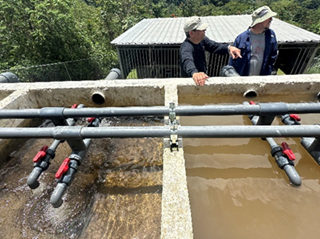Clean Water Solutions for Puerto Rico’s Isolated Communities
Improving Water Quality for Remote Areas

In rural areas in Puerto Rico, small water systems face challenges maintaining water quality due to limited resources, aging infrastructure, vulnerability to hurricanes and widespread pollution. These issues threaten water quality and public health—especially in isolated communities. Improving these water systems can lead to better health outcomes, promote economic growth, protect the environment and improve lives.
EPA researchers are working with partners to help communities in rural southeastern Puerto Rico improve water use, treatment and safety—and working to gather more data to support better decision-making and speed up long-term solutions.
EPA Projects to Empower Communities
- Project 1: Understanding Household Water Use and Treatment: This project looks at how people use and treat water that doesn’t come from public systems. Surveys and water samples will help identify ways to improve and maintain these water treatment systems.
- Project 2: Improving Water Storage and Health Literacy: This project focuses on how water is used, stored and treated at home and in the community. Results will help residents learn about best practices and understand potential health risks.
Addressing Data Gaps for Better Decisions
One of the biggest obstacles to improving water quality in rural Puerto Rico is the lack of reliable data. Most people in Puerto Rico get their water from the Puerto Rico Aqueduct and Sewer Authority (PRASA). However, about 90,000 people depend on 240 small community-managed water systems called “non-PRASA” in remote mountain areas.
These systems often:

- Serve fewer than 500 people
- Lack proper treatment infrastructure
- Managed by volunteers and not trained operators
- Unable to meet Safe Drinking Water Act Standards
Environmental challenges such as rugged terrain and natural disasters make make it hard to maintain these water systems. Without proper treatment, these systems may expose residents to harmful germs like cholera.
Cistern Use and Storage Risks
Many non-PRASA communities use cisterns or rainwater storage tanks to collect water during shortages or system maintenance. However, they face several challenges:
- There are few standards for using cistern safely
- Water sources and treatment methods vary widely
- There is limited water quality data
Without clear standards or water quality data, it is challenging to measure health risks—especially during emergencies.
A Collaborative Research Effort
EPA is working with individuals, students, and community leaders in non-PRASA communities to study how cisterns are used and the health risks involved. The team includes:
- EPA researchers from the Office of Research and Development and EPA Region 2

- Scientists from Inter American University of Puerto Rico’s Center for Environmental Education, Conservation and Research (CECIA)
- Residents of seven non-PRASA communities
Together they are evaluating social behaviors, storage methods and public health impacts to better understand and address these issues.
Sharing Results and Empowering Communities
EPA is creating a summary report—including translated visuals—to share findings . This work will improve local understanding of water issues, encourage safer water practices, and expand access to clean and safe drinking water.
Sharing clear, easy-to-understand data helps communities make informed choices and strengthens environmental health.
Learn more about EPA in Puerto Rico:
Visit EPA in Puerto Rico
